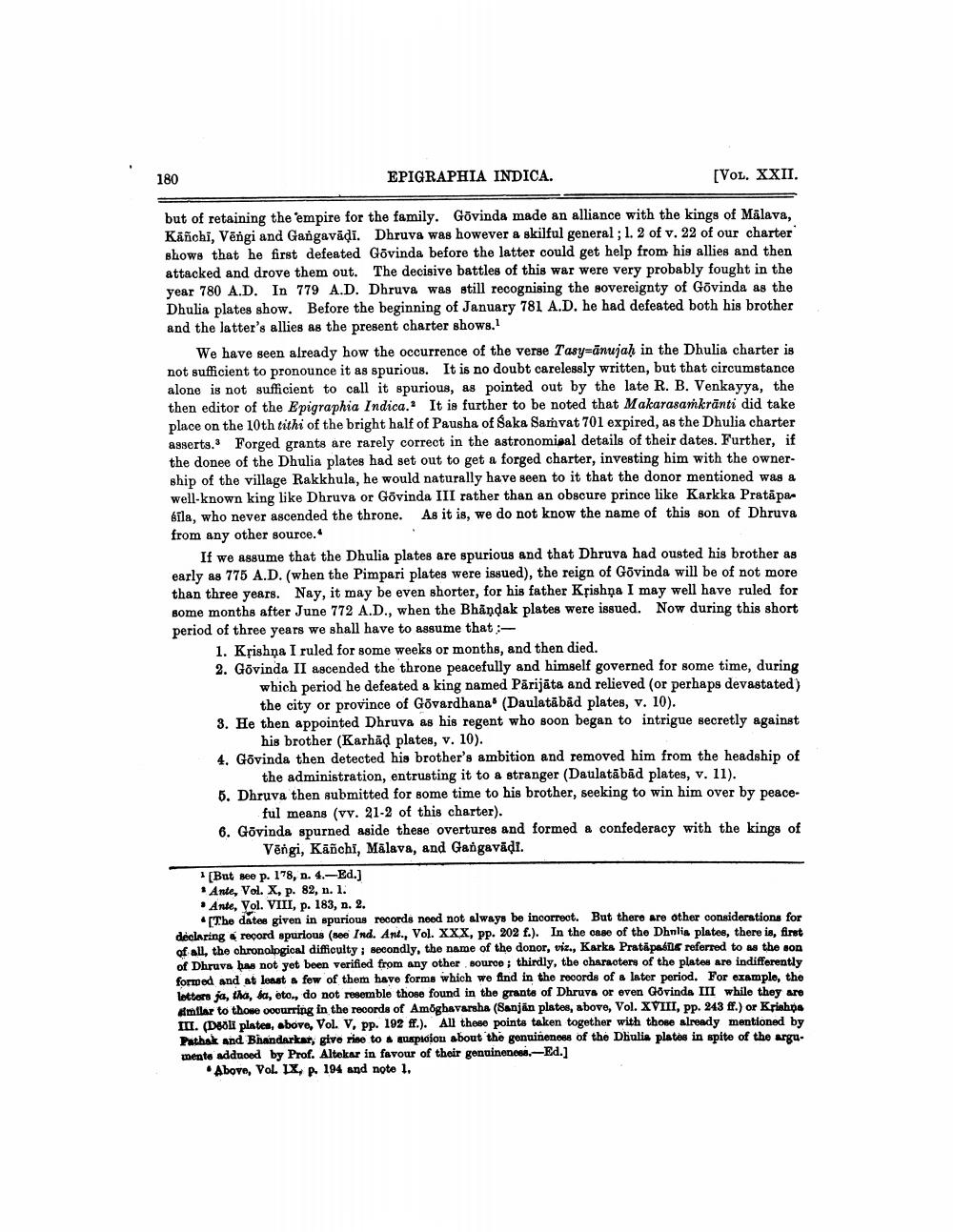________________
EPIGRAPHIA INDICA.
[VOL. XXII.
but of retaining the empire for the family. Govinda made an alliance with the kings of Malava, Kañchi, Vengi and Gangavaḍi. Dhruva was however a skilful general; 1. 2 of v. 22 of our charter shows that he first defeated Govinda before the latter could get help from his allies and then attacked and drove them out. The decisive battles of this war were very probably fought in the year 780 A.D. In 779 A.D. Dhruva was still recognising the sovereignty of Govinda as the Dhulia plates show. Before the beginning of January 781 A.D. he had defeated both his brother and the latter's allies as the present charter shows.1
180
We have seen already how the occurrence of the verse Tasy-anujaḥ in the Dhulia charter is not sufficient to pronounce it as spurious. It is no doubt carelessly written, but that circumstance alone is not sufficient to call it spurious, as pointed out by the late R. B. Venkayya, the then editor of the Epigraphia Indica. It is further to be noted that Makarasamkrānti did take place on the 10th tithi of the bright half of Pausha of Saka Samvat 701 expired, as the Dhulia charter asserts. Forged grants are rarely correct in the astronomisal details of their dates. Further, if the donee of the Dhulia plates had set out to get a forged charter, investing him with the ownership of the village Rakkhula, he would naturally have seen to it that the donor mentioned was a well-known king like Dhruva or Govinda III rather than an obscure prince like Karkka Pratapa sila, who never ascended the throne. As it is, we do not know the name of this son of Dhruva from any other source.
If we assume that the Dhulia plates are spurious and that Dhruva had ousted his brother as early as 775 A.D. (when the Pimpari plates were issued), the reign of Govinda will be of not more than three years. Nay, it may be even shorter, for his father Krishna I may well have ruled for some months after June 772 A.D., when the Bhāṇḍak plates were issued. Now during this short period of three years we shall have to assume that:
1. Krishna I ruled for some weeks or months, and then died.
2. Govinda II ascended the throne peacefully and himself governed for some time, during which period he defeated a king named Pārijāta and relieved (or perhaps devastated) the city or province of Govardhana (Daulatabad plates, v. 10).
3. He then appointed Dhruva as his regent who soon began to intrigue secretly against his brother (Karhad plates, v. 10).
4. Govinda then detected his brother's ambition and removed him from the headship of the administration, entrusting it to a stranger (Daulatābād plates, v. 11).
5. Dhruva then submitted for some time to his brother, seeking to win him over by peace
ful means (vv. 21-2 of this charter).
6. Govinda spurned aside these overtures and formed a confederacy with the kings of Vengi, Kanchi, Malava, and Gangavāḍī.
[But see p. 178, n. 4.-Ed.]
Ante, Vol. X, p. 82, n. 1.
Ante, Vol. VIII, p. 183, n. 2.
[The dates given in spurious records need not always be incorrect. But there are other considerations for declaring a record spurious (see Ind. Ant., Vol. XXX, pp. 202 f.). In the case of the Dhulia plates, there is, first of all, the chronological difficulty; secondly, the name of the donor, viz., Karka Pratapaśile referred to as the son of Dhruva has not yet been verified from any other source; thirdly, the characters of the plates are indifferently formed and at least a few of them have forms which we find in the records of a later period. For example, the letters ja, tha, ba, etc., do not resemble those found in the grants of Dhruva or even Govinda III while they are similar to those occurring in the records of Amoghavarsha (Sanjan plates, above, Vol. XVIII, pp. 243 ff.) or Krishna III. (Deoli plates, above, Vol. V, pp. 192 ff.). All these points taken together with those already mentioned by Pathak and Bhandarkar, give rise to a suspicion about the genuineness of the Dhulia plates in spite of the argumente adduced by Prof. Altekar in favour of their genuineness.-Ed.]
Above, Vol. IX, p. 194 and note 1.




